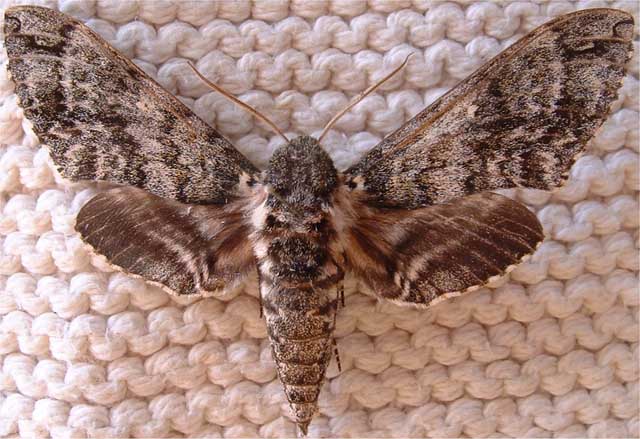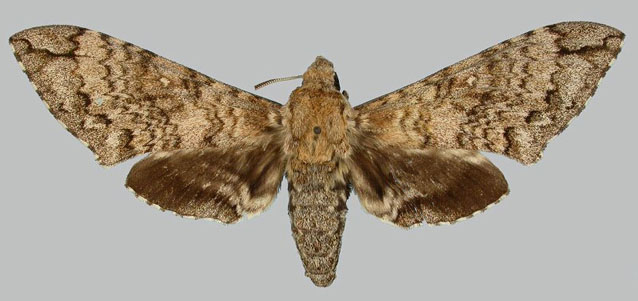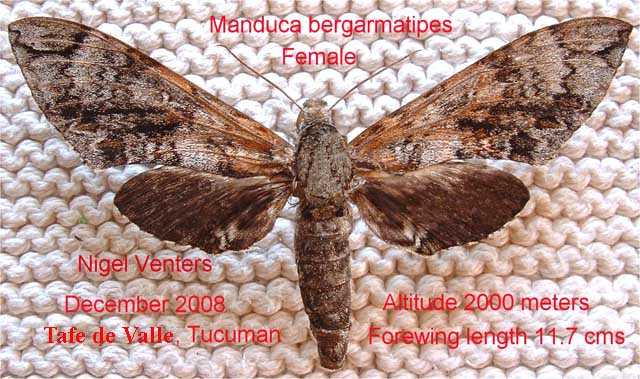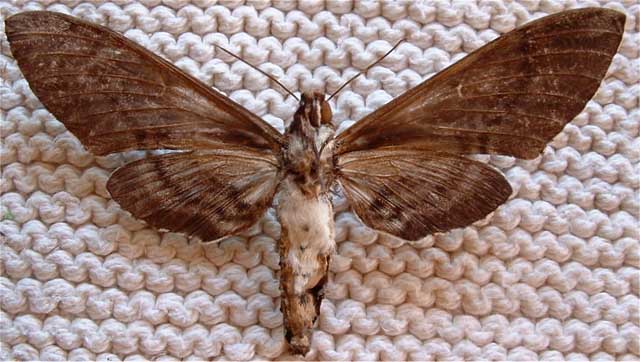Manduca bergamatipes
|
|
Updated as per the L.O.L.A. publication Hawkmoths of Argentina, More,
Kitching and Cocucci, 2005, October 2007.
Updated as per personal communication with Nigel Venters (wingspan: 88mm, Tafe de Valle, Tucuman, Argentina, November 26, 2008, 2000m),
February 12, 2009
Updated as per SHILAP publication: Lista de Sphingidae del Uruguay, September, 2010; Msc Gabriela Bentancur Viglione; January 31, 2011
Updated as per CATE, October 17, 2011
Updated as per personal communication with Ezequiel Bustos (Shilap revta. lepid. 43 (172) diciembre, 2015, 615-631 eISSN 2340-4078 ISSN 0300-5267), January 4, 2016
|
Manduca bergarmatipes
(B. P. Clark, 1927) Protoparce

Manduca bergarmatipes, Tafe de Valle, Tucuman, Argentina,
wingspan: 88mm, November 26, 2008, 2000m, courtesy of Nigel Venters.
This site has been created by
Bill Oehlke at oehlkew@islandtelecom.com
Comments, suggestions and/or additional information are welcomed by Bill.
TAXONOMY:
Family: Sphingidae, Latreille, 1802
Subfamily: Sphinginae, Latreille, [1802]
Tribe: Sphingini, Latreille, 1802
Genus: Manduca Hubner, [1807] ...........
Species: bergarmatipes (B. P. Clark, 1927)
|
MIDI MUSIC
.....It's a Wonderful World.....
copyright C. Odenkirk
ON.OFF
<bgsound src="world.mid" LOOP=FOREVER>
|
DISTRIBUTION:
Manduca bergarmatipes (wingspan: males: approximately 88mm; females: 117mm; forewing length: males: 45-47mm)
flies in Argentina: Tucuman; and
Uruguay.
CATE" "
Intermediate in appearance between Manduca bergi and Manduca armatipes. Most similar Manduca armatipes but:
Abdomen ash grey dorsally.
Abdomen ventrally white with 2 medial black spots (4 in Manduca armatipes).
Forewing upperside less heavily marked (more so than in Manduca bergi); subbasal white spots present but less prominent; discal spot present but smaller and
less prominent.
Forewing underside less heavily marked (more so than in Manduca bergi); discal spot present but smaller and less prominent.
Hindwing upperside darker; median white line prominent posteriorly, broader but shorter.
Hindwing underside black, with transverse lines less prominent (more so than in Manduca bergi)."

Manduca bergarmatipes, Tucuman, Argentina, CATE,
on my home computer only.
FLIGHT TIMES:
Manduca bergarmatipes adults
fly in November (probably into December) and possibly in other months.
ECLOSION:
Pupae probably wiggle to surface from
subterranean chambers just prior to eclosion.

Manduca bergarmatipes female, Tafe de Valle, Tucuman, Argentina,
wingspan: 117mm, December, 2008, 2000m, courtesy of Nigel Venters.

Manduca bergarmatipes female (verso), Tafe de Valle, Tucuman, Argentina,
wingspan: 117mm, December, 2008, 2000m, courtesy of Nigel Venters.
SCENTING AND MATING:
Females call in the males with a
pheromone released from a gland at the tip of the
abdomen. Adults take nectar from flowers.
EGGS, LARVAE, PUPAE:
Larval hosts are unknown. This is apparently quite a rare species.
Return to Sphingidae Index
Return to Sphingini Tribe
 | 
Show appreciation for this site by clicking on flashing butterfly to the left.
The link will take you to a page with links to many insect sites. |





